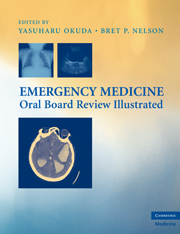Book contents
- Frontmatter
- Contents
- Contributors
- 1 How to Use This Book
- 2 EM Medical Decision Making
- 3 About the Oral Boards: The Approach and Practical Tips
- CASES
- Appendix A The Chest Pain Patient: Five Life-Threatening Causes and Critical Actions
- Appendix B The Confused Patient: Ten Most Common Causes and Critical Actions
- Appendix C The Poisoned Patient: Most Common Toxidromes and Treatments
- Appendix D The Trauma Patient: The Approach and Important Principles
- Appendix E Advanced Cardiac Life Support Review
- Appendix F Pediatric Pearls: High-Yield Facts from Fever to Drugs
- Appendix G Twenty Common Emergency Medicine Procedures: Indications, Contraindications, Technique, and Complications
- Appendix H Image Answer Key
- Index
- Plate section
Appendix C - The Poisoned Patient: Most Common Toxidromes and Treatments
Published online by Cambridge University Press: 04 August 2010
- Frontmatter
- Contents
- Contributors
- 1 How to Use This Book
- 2 EM Medical Decision Making
- 3 About the Oral Boards: The Approach and Practical Tips
- CASES
- Appendix A The Chest Pain Patient: Five Life-Threatening Causes and Critical Actions
- Appendix B The Confused Patient: Ten Most Common Causes and Critical Actions
- Appendix C The Poisoned Patient: Most Common Toxidromes and Treatments
- Appendix D The Trauma Patient: The Approach and Important Principles
- Appendix E Advanced Cardiac Life Support Review
- Appendix F Pediatric Pearls: High-Yield Facts from Fever to Drugs
- Appendix G Twenty Common Emergency Medicine Procedures: Indications, Contraindications, Technique, and Complications
- Appendix H Image Answer Key
- Index
- Plate section
Summary
Stabilization
The clinical management of the overdosed or poisoned patient is underscored by the basic principle of treating the patient and not the poison. In following this clinical tenet, the critically ill poisoned patient is rapidly stabilized during the primary survey, emphasizing the ABCs to correct airway, breathing, and circulatory problems. Abnormalities in the patient's vital signs (heart rate, blood pressure, temperature, respiratory rate, pulse oxymetry, and finger stick glucose) are also corrected at this time.
History
As with other patients, a key element in the approach to the poisoned patient is in obtaining a history of present illness. The presentation of the overdosed/poisoned patient will depend on both the patient and the toxin. Therefore it is important to ask about the patient's general medical condition, medications and allergies, and the circumstances surrounding the overdose/poisoning. It is also important to inquire about what toxin(s) the patient may have access to, and the dose, route, and time of overdose/poisoning. When inquiring about the circumstances surrounding the event, it is important to ask what signs and symptoms were experienced, their onset, and if anything has been done about them.
As there are many toxins, there are many toxidromes to be identified. This undertaking may seem daunting. However, it is simplified by classifying the toxidromes into categories that correspond to a large pharmacological class (ie, opioids, sympathomimetics, cholinergics, etc). This is important since a specific agent may give you most but not all the signs and symptoms of that particular class of toxin. However, this information may be enough to suggest the correct agent implicated.
- Type
- Chapter
- Information
- Emergency Medicine Oral Board Review Illustrated , pp. 493 - 496Publisher: Cambridge University PressPrint publication year: 2009



